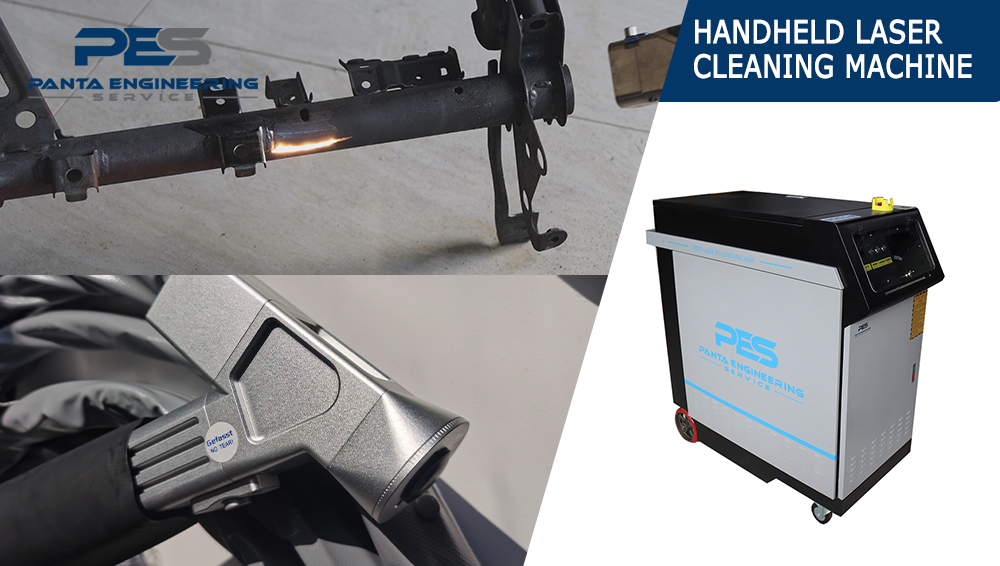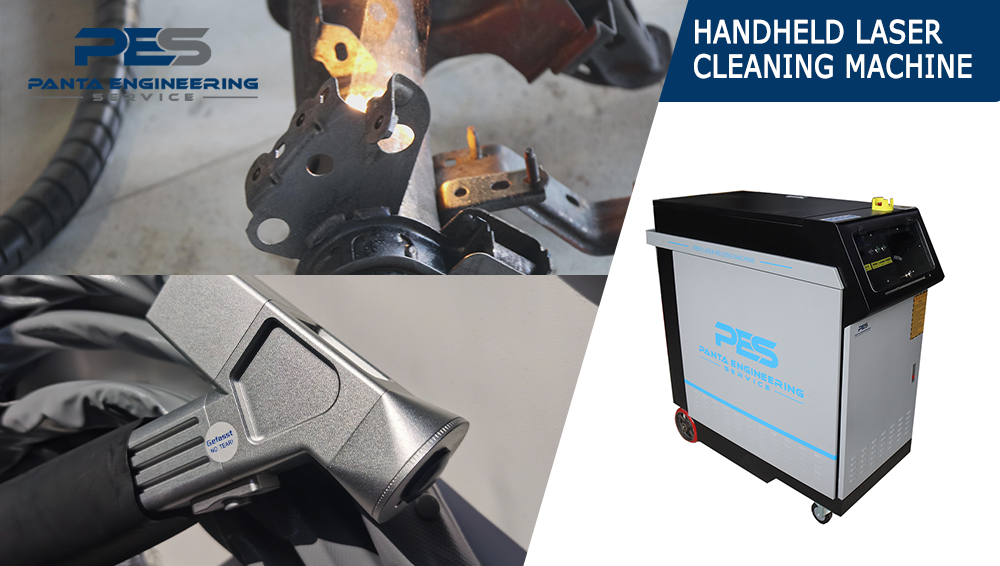Categories
New Blog
Advantages and application industries of laser cleaning machines 2
Aug 23, 2022

Laser cleaning machines are more and more widely used in industrial applications
While the applications of lasers in cutting, drilling and welding are well known, their application in industrial cleaning is relatively new and has a wide, unexplored space.
Laser cleaning applications are primarily driven by the market need for a non-toxic, non-abrasive cleaning method that can be used as an alternative to the previously used chemical cleaning, hand cleaning and abrasive jet cleaning methods.
Advantages of Laser Cleaning
The main problems with traditional cleaning methods include: negative impact on the environment and wear on the substrate. Abrasive blasting systems generate large amounts of waste and can damage the delicate surfaces of substrates; cleaning with chemical solvents produces potentially hazardous vapor and liquid waste.
The shortcomings of traditional cleaning methods have prompted the application of laser technology in the field of surface cleaning. Due to its many advantages, laser cleaning is now the most effective method for removing unwanted substances from the surface of materials.
The main advantages of using a laser cleaner in surface cleaning applications include:
• Automated cleaning methods
• Reduce the amount of waste
• Improve security
• No chemicals or sandblasting required
• Non-abrasive and non-contact cleaning process

Application of laser cleaning machine
1. Surface polishing and derusting in steel manufacturing
Laser cleaning is also an effective and efficient method for removing rust and oxide layers from the surface of metal materials. Rust and oxide layers are contaminants that form on metal surfaces due to natural or artificial processes. When metals are exposed to moisture, they react with water to form ferrous oxide, which rusts. This rust can degrade the metal, making it unsuitable for use in many applications.
On the other hand, due to the heat treatment process, an oxide layer forms on the metal surface, which discolors the metal surface and hinders subsequent finishing operations.
To remove these unwanted surface deposits, descaling treatments are required to provide a smooth surface for pre-finishing and finishing, such as electroplating.
Traditional rust and scale removal methods include physical methods such as sandblasting, polishing, scraping devices, additional purging and wire brushing, etc. There are also chemical methods such as the use of alkaline or acidic chemicals to remove oxide layers. However, these methods not only cause environmental pollution, but also damage the base metal.
To avoid these disadvantages, laser cleaning has become the method of choice for rust and descaling operations. The rust layer/oxide layer is removed by irradiating a laser beam with high peak power and high repetition rate on the rust layer.
The laser must be fired in short pulses to avoid damage to the base metal. The rust rapidly absorbs the energy of the laser beam, causing the temperature to rise. Once the temperature is high enough, the rust will melt and eventually evaporate.
Pulsed fiber lasers are preferred as they offer greater control over power, wavelength and pulse duration, allowing the rust/oxide layer to evaporate without causing any damage to the substrate material.
Laser cleaning can also be used for surface cleaning. Before applying a corrosion-resistant protective coating to steel parts, the surface of the part must be cleaned and free of any contaminants.
Surface cleaning/preparation requires removal of all contamination from the surface of steel parts in preparation for the application of a protective coating. These contaminants include oils, greases, oxide layers, hydrates, shop primers, and more.
Because fiber laser cleaning uses a non-abrasive, non-contact method that involves no solvents, chemicals, or abrasive media, it is ideal for surface cleaning preparation and rust/scale removal. The cleaning process can be performed on a small or large scale, and the cleaning process can be automated. Laser cleaning is an environmentally friendly, cost-effective method of rust removal that prepares parts for a protective coating.
2. Cleaning the anode assembly
The aluminium smelting industry uses carbon blocks as "sacrificial" anodes in primary aluminium production. The quality of the anode has an impact on the environmental, economic and technical aspects of aluminium production. A small fraction of the cell power is used to overcome the resistance of the prebaked anode.
The presence of dirt and other contaminants increases the resistance of the anode, which leads to more battery power consumption. The presence of contaminants also shortens the life of the anode by increasing the rate at which it is consumed during the smelting process. From an efficiency standpoint, it is necessary to clean and remove all contaminants from the surface of the anode assembly prior to use in aluminum smelting operations.
Furthermore, anode assemblies are valuable tools that can be reused, but their major components must be thoroughly and carefully handled under specific conditions.
Laser cleaning can meet specific conditions for the reusability of anode assemblies. Laser cleaning can be used for:
◎ Remove carbon bottom residue
◎ Clean the cathode rod
◎ Remove contamination from casing and short rod
3. Preparing for Metal Bonding
In order to improve process stability, surface adhesion and better welding quality, the surfaces of the metal materials to be joined must be prepared before welding and other joining techniques are applied.
Without the necessary cleaning of metallic surfaces, joints and seams are prone to degradation, increased wear and even catastrophic failure. Laser cleaning can be used to treat surfaces prior to joining, resulting in excellent bond strength, improved corrosion resistance and durability.
Laser cleaner is suitable for bond preparation because it removes oxides and other contaminants such as grease and oxides that can reduce bond strength. Laser cleaning is especially useful for applications involving curved surfaces, or for cleaning parts with highly complex three-dimensional geometries.
A major benefit of laser cleaning is the ability to fine-tune its power and wavelength for precise corrections to metals used for microstructuring, such as magnesium and aluminum. It also imparts high corrosion resistance to the material, ensuring stable, long-lasting bonds.
In recent years, bonding methods have been increasingly used in structural design applications, rather than traditional joining techniques such as riveting and welding. This is because the bonding method has many advantages over conventional techniques.
These benefits include uniform stress distribution, corrosion reduction, structural lightening, vibration damping, and sound insulation. However, these benefits can only be achieved if the surfaces to be bonded are carefully cleaned.
Laser cleaning is ideal for such applications as it carefully removes oil, rust, protective coatings and other contaminants from shipping without causing damage to the substrate material.
4. Pretreatment for brazing and welding
Laser cleaning has also been shown to be effective in pretreatment applications for welding and brazing. In shipbuilding, precision toolmaking, automotive and other related industries, aluminum and steel surfaces must be prepared before they can be welded.
Laser welding preparation is one of the many applications of laser cleaning to help remove ferrous and non-ferrous metals, lubricants, and other contaminants from metal and aluminum surfaces in preparation for high-quality welding. It also ensures smooth and non-porous brazing seams.
When used in pretreatment for welding and brazing, laser cleaning does the following:
◎ Thoroughly removes shop primer, hydrate and oxide layers
◎ Remove grease and oil stains
In addition to welding and brazing preparation, lasers can be used to remove welding residues such as residual flux and oxide materials, as well as heat stains on finished welded joints.
The benefits of using laser cleaning in welding and brazing pretreatment include:
◎ Adjustable wavelength and power for precise processing of joint surfaces in various material thickness ranges
◎ No damage to the base material (ie, the galvanized layer of the steel plate)
5. Topical removal of coating
Laser cleaning is particularly effective in applications that require partial removal of paint or coatings from surfaces. It can be used on almost all surface types, whether chemically anodized, oxidized or organic. Laser cleaning removes coatings and paints while maintaining the integrity of substrate materials in the automotive and aerospace industries.
For coating removal applications, fiber lasers are the first choice. They overcome some of the inherent challenges faced in topical decoating applications in the past by precisely removing the coating in a specified area. Lasers can be used for:
◎ Precise treatment of functional and design surfaces
◎ Create Faraday cages and continuity contacts for the aerospace industry
◎ Partial removal of paint for electromagnetic compatibility
◎ Provide junction for wire connection
◎ Tape coatings in the electronics and automotive industries
Handheld laser cleaning is very effective in situations where critical welds on painted structures/parts must be removed for inspection. Lasers can remove coatings without the need for hand or power tools, abrasives or chemicals that can hide problem areas and cause further damage to the surface.
6. Selective paint removal
Selective paint removal is one of the many applications of laser cleaning. In the automotive and aerospace industries, it is sometimes necessary to remove the top layer of paint while protecting the primer. Typically, the top weathered coating on a vehicle needs to be completely removed before new paint is applied.
Since the physical and chemical properties of the top layer of paint are different from the primer, the power and frequency of the laser can be set to remove only the top layer of paint.
Since the laser has no mechanical, chemical or thermal effects on the primer, the primer remains intact. This ensures the corrosion resistance of the primer. When bare metal is required between parts to achieve metal-to-metal electrical contact, the laser cleaning process is best because it saves time and materials and improves the surface quality of the finished product.
At present,hand held laser cleaner is mainly used to clean rust, paint, etc. on the surface of small parts. Of course, this machine is also most likely suitable for cleaning large surfaces and large equipment/structures. With the current progress in the field, these visions are expected to become a reality in the near future.